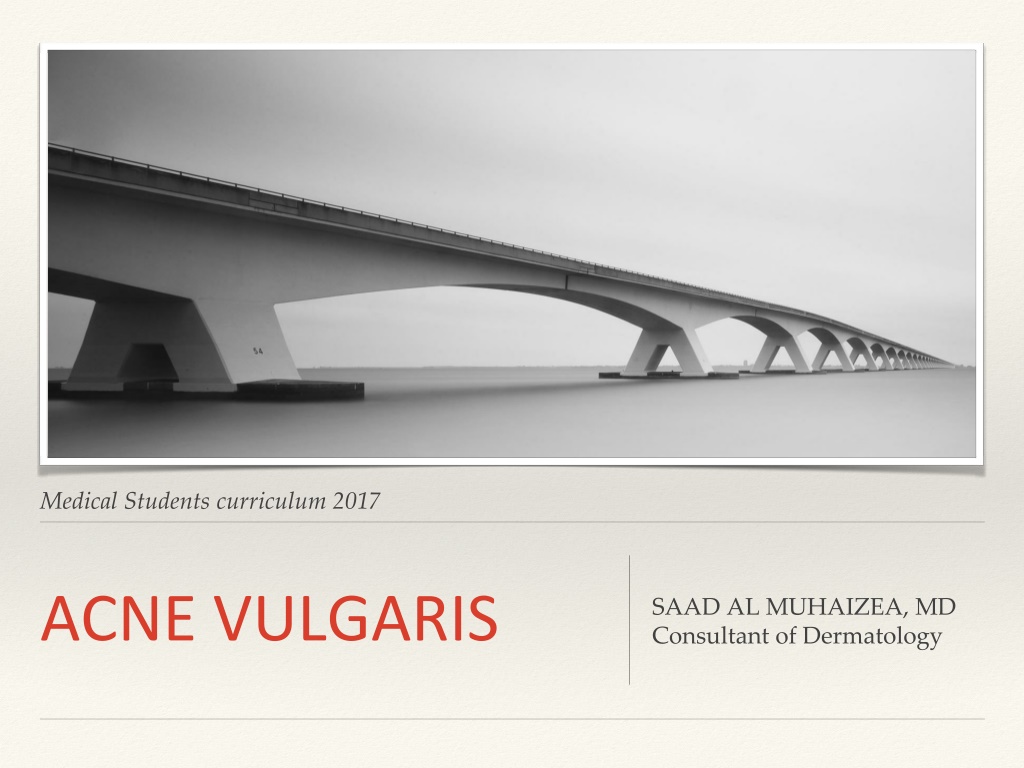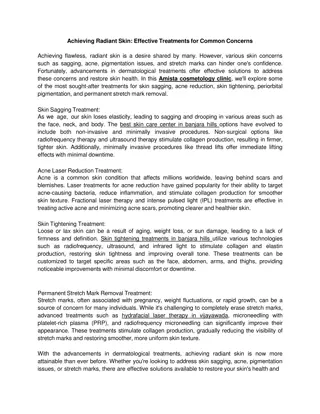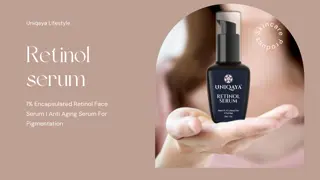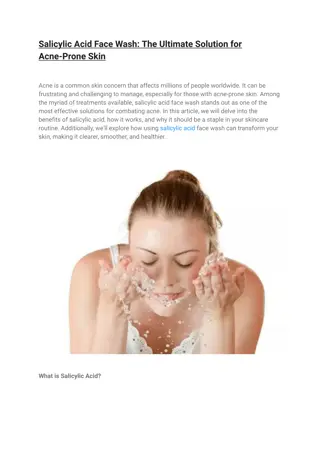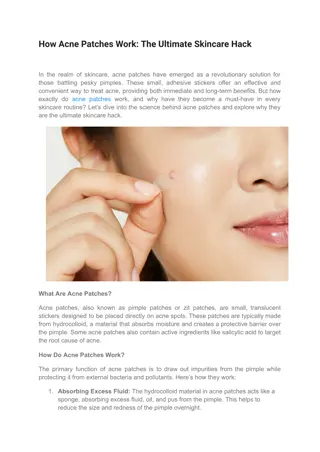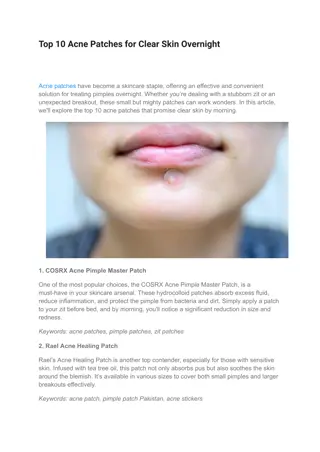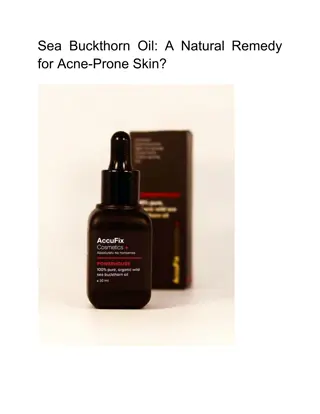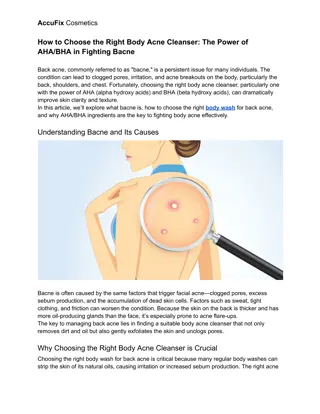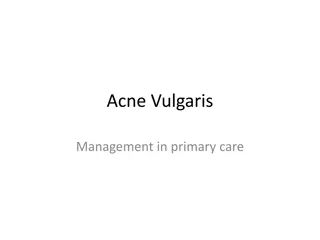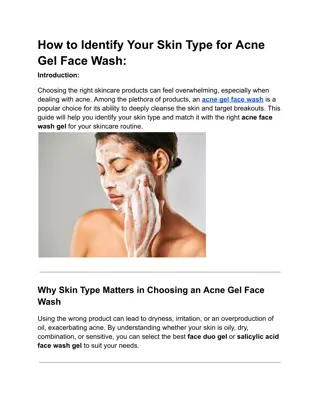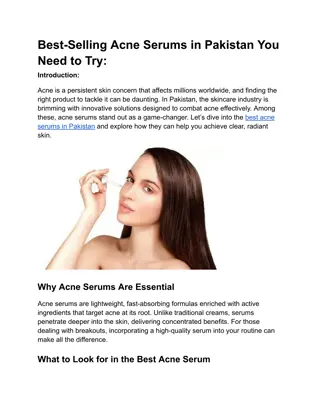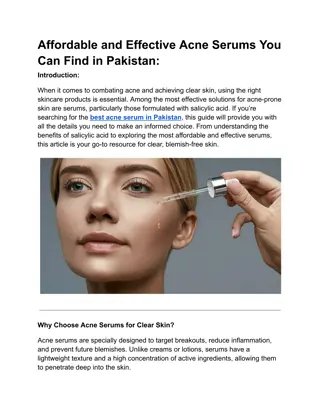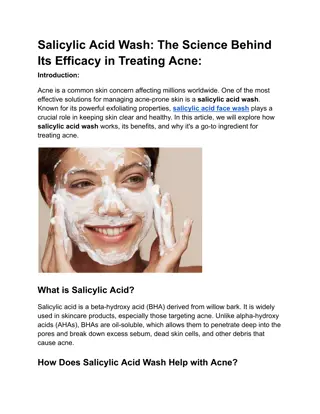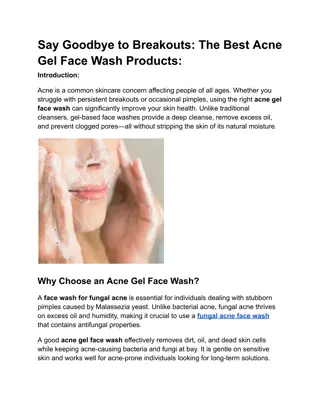ACNE VULGARIS
Acne vulgaris is a common skin disorder affecting adolescents, with significant psychological impacts. This skin condition primarily affects pilosebaceous follicles and is characterized by factors like hyperkeratosis, increased sebum production, and bacterial presence. Different types of acne include inflammatory acne and cysts, each with its own characteristics and potential for scarring. It is crucial for physicians to be knowledgeable about acne vulgaris and its treatment options to provide effective care.
Download Presentation

Please find below an Image/Link to download the presentation.
The content on the website is provided AS IS for your information and personal use only. It may not be sold, licensed, or shared on other websites without obtaining consent from the author.If you encounter any issues during the download, it is possible that the publisher has removed the file from their server.
You are allowed to download the files provided on this website for personal or commercial use, subject to the condition that they are used lawfully. All files are the property of their respective owners.
The content on the website is provided AS IS for your information and personal use only. It may not be sold, licensed, or shared on other websites without obtaining consent from the author.
E N D
Presentation Transcript
Medical Students curriculum 2017 ACNE VULGARIS SAAD AL MUHAIZEA, MD Consultant of Dermatology
Importance 85% adolescents experience it Prevalence of comedones (lesions) in adolescents approaches 100% Acne vulgaris is the most common cutaneous disorder in the U.S. 10 percent of all patient encounters with primary care physicians. Pts can experience significant psychological morbidity and, rarely, mortality due to suicide. Important that physicians are familiar with Acne Vulgaris and its treatment.
pilosebaceous units in the dermis These units consist of hair follicle and the associated sebaceous glands. They are connected to the skin by a duct(infundibulum) through which the hair shaft passes. The cause of acne is an increase in the activity of the sebaceous glands and the epithelial tissue lining the infundibulum.
Etiology, signs and symptoms Acne vulgaris is a disease of pilosebaceous follicles. Factors: Retention hyperkeratosis. Increased sebum production. Propionibacterium acnes within the follicle. Inflammation
Microcomedone hyperkeratotic plug made of sebum and keratin in follicular canal Closed comedones (whiteheads) Open comedo (blackhead(
Inflammatory Acne Acne characterized by inflammation surrounding the comedones, papules, pustules, and nodulocystic lesions. it may cause permanent scarring. Normal sebum does not contain free fatty acids and is nonirritating, however, in the presence of biolytic enzymes produced by P.acne) , triglycerides of the sebum are split and release fatty acids which are irritating to the tissue. The inflamed follicle or pustules either heal in about a week or develop in to cyst or sterile abscesses, which can lead to scaring.
Cysts when follicles rupture into surrounding tissues, resulting in papule/pustule/nodule.
Severity of Acne Typical mild acne: comedones predominate More severe cases: pustules and papules predominate, heal with scar if deep Acne Conglobata: suppurating cystic lesions predominate, and severe scarring results
Aggravating Factors Change in sebaceous activity and hormonal level (e.g. before or during premenstrual cycle) High humidity conditions Local irritation or friction Rough or occlusive clothing Cosmetics( having greasy base) Diet; chocolate, nuts, fats colas, or carbohydrates. Oils greases , or dyes in hair product.
Medications That Can Cause Acne ACTH Azathioprine Barbiturates Isoniazid Lithium phenytoin Disulfiram Halogens Iodides Steroids Cyclosporine Vitamins B2,6,12
Treatment of Acne Vulgaris depends on type of clinical lesions Microcomedone matures in 8 weeks Therapy must continue beyond this time frame considerable heterogeneity in the acne literature, and no clear evidence-based guidelines are available
Ingredients in OTC products Sulfur 2-10 % other forms, such as zinc sulfide or sodium thiosulfate. Sulfur presents a paradox in that it helps resolve formed comedones but may promote the formation of new ones. Due to this comedogenic effect, the use of salicylic acid or resorcinol is preferred.
Ingredients in OTC products Benzoyl peroxide;(5 to 10%)a primary irritant. Salicylic acid is used in concentration of o.5 to 2%. Applied at night after washing the affected area with soap and water. Resorcinol(1 to 4%) may produce a dark brown scale on some black- skinned people.
Tretinoin Transe retinoic acid The acid form of vitamin A, is a strong primary irritant. The products are applied at night. They cause a feeling of warmth or slight stinging . Optimum results occur in3 to 4 months. Care should be taken to avoid touching with eyes, nose, and mouth with tretinoin. Exposure to strong sunlight should be avoided because of the increased sensitivity of the skin. Does not cause the toxic effects of a large doses of vitamin A
Antibiotics Tetracycline and some other antibiotics orally administered reduce bacterial population and the concentration of the fatty acids in the sebaceous follicle. Topical antibacterial agents generally are ineffective, because acne is not an infection.
Antibiotics ERYTHROMYCIN: Erythromycin reduce level of fatty acid of the follicles. It is lipid soluble antibiotics which can penetrate the sebaceous follicle.
Comedonal acne Other topical agents: Useful when topical retinoids not tolerated Salicylic acid (promotes desquamation) Azelaic acid (antimicrobial, reduces hyperpigminetation) Gycolic acid Sulfur in OTC rx (keratolytic)
Mild to moderate inflammatory acne Benzoyl peroxide: (antimicrobial, anticomedonal, pregnancy risk C) Topical antibiotic Combination of both Combination rx more effective than mono in increased inflammatory lesions.
Moderate to severe acne: Oral isotretinoin Reduces sebaceous gland size/sebum production regulates cell proliferation and differentiation Effect last 1 yr after cessation Only med altering course of A. Vulgaris
Moderate to severe acne: oral isotretinoin Adverse effects can be severe: Inc TG, teratogenic, bone marrow suppression, hepatotoxicity, top 10 drugs for suicide/depression reports. FDA practice rules: 2 negative pregnancy tests before rx Pregnancy test each month (bring pt in) Pregnancy risk pts must use 2 contraceptive for at least 1 mo prior to rx.
Moderate to severe acne: Oral antibiotics -Tetracycline - minocycline - doxycycline - erythromycin - TMP-SMX - clindamycin Given daily over 4-6 mo, with taper.
Patient FAQs Soaps, detergents remove sebum but do not alter production Avoid occlusive clothing Water based cosmetic better than oil based Diet modification no role in Rx
Neonatal Acne First four weeks of life Develops a few days after birth Facial papules or pustules Cases that persist beyond 4 weeks or have an onset after R/O acne cosmetic, acne venenata, drug-induced acne
SAPHO Syndrome Synovitis, Acne, Pustulosis, Hyperostosis, and Osteomyelitis Acne fulminans, acne conglobata, pustular psoriasis, and palmoplantar pustulosis Chest wall is most site of musculoskeletal complaints
Acne Conglobata Conglobate: shaped in a rounded mass or ball Severe form of acne characterized by numerous comedones, large abscesses with sinuses, grouped inflammatory nodules Suppuration Cysts on forehead, cheeks, and neck
Acne Conglobata Occurs most frequently in young men Follicular Occlusion Triad: acne conglobata, hiradenitis suppurva, cellulitis of the scalp Heals with scarring Treatment; oral isotretinoin for 5 months
Acne Fulminans Rare form of extremely severe cystic acne Teenage boys, chest and back Rapid degeneration of nodules leaving ulceration Fever, leukocytosis, arthralgias are common Tx; oral steroids, isotretinoin
Tropical Acne Nodular, cystic, and pustular lesions on back, buttocks, and thighs Face is spared Young adult military stationed in tropics
Acne Venenata Contact with acnegenic chemicals can produce comedones Chlorinated hydrocarbons, cutting oils, petroleum oil, coal tar Radiation therapy
Acne Cosmetica Closed comedones and papulopustules on the chin and cheeks May take months to clear after stopping cosmetic product Pomade Acne; blacks, males, due to greases or oils applied to hair
Acne Detergicans Patients wash face with comedogenic soaps Closed comedones TX; wash only once or twice a day with non- comedogenic soap
Acne Aestivalis Aka; Mallorca acne Rare, females 25-40 yrs Starts in spring, resolves by fall Small papules on cheeks, neck, upper body Comedones and pustules are sparse or absent Tx; retinoic acid, abx don t help
Excoriated Acne Aka; picker s acne Girls, minute or trivial primary lesions are made worse by squeezing Crusts, scarring, and atrophy TX; eliminate magnifying mirror, r/o depression
Acneiform Eruptions Originate from skin exposure to various industrial chemicals Papules and pustules not confined to usual sites of acne vulgaris Chlorinated hydrocarbons, oils, coal tar Oral meds; iodides, bromides, lithium, steroids (steroid acne)
Gram Negative Folliculitis Occurs in patients treated with antibiotics for acne over a long-term Enterobactor, Klebsiella, Proteus Anterior nares colonized Tx; isotretinoin, Augmentin
Acne Keloidalis Folliculitis of the deep levels of the hair follicle that progresses into a perifolliculitis Occurs at nuchal area in blacks or Asian men Not associated with acne vulgaris Hypertrophic connective tissue becomes sclerotic, free hairs trapped in the dermis contribute to inflammation Tx; intralesional Kenalog, surgery
Hiradenitis Suppurativa Disease of the apocrine gland Axillae, groin, buttocks, also areola Obesity and genetic tendency to acne Tender red nodules become fluctuant and painful Rupture, suppuration, formation of sinus tracts
Hiradenitis Suppurativa Most frequently axillae of young women Men usually groin and perianal area Follicular keratinization with plugging of the apocrine duct; dilation and inflammation
Hiradenitis Suppurativa Oral antibiotics, culture S. aureus, gram-negatives Intralesional steroids, surgery Isotretinoin helpful in some cases
Dissecting cellulitis of the scalp Uncommon suppurative disease Nodules suppurate and undermine to form sinuses Scarring and alopecia Adult black men most common, vertex and occiput
Dissecting cellulitis of the scalp Tx; intralesional steroids, isotretinoin, oral abx, surgical incision and drainage
Pyoderma Faciale Postadolescent girls, reddish cyanotic erythema with abscesses and cysts Distinguished from acne by absence of comedones, rapid onset, fulminant course and absence of acne on the back and chest Tx; oral steroids followed by isotretinoin
